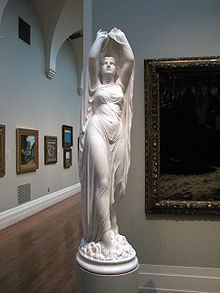Elemental

An Elemental is a spirit embodying one of the five elements of antiquity: Earth (solid), Water (liquid), Wind (gas), Fire (heat), Aether (quintessence.) Elementals are referred to by various names. In the English European tradition these include Fairies, Elves, Devas, Brownies, Leprechauns, Gnomes, Sprites, Pixies, Banshees, Goblins, Dryads, Mermaids, Trolls, Dragons, Griffins, and numerous others. These nature spirits are governed by the Archangels. Like Angels, Elementals have a recognisable appearance consistently depicted by the archetypal language of art and literature. For example, it is easy to determine if a drawing is an Angel or a winged elemental. Angels have feathered bird-like wings and the winged Elementals have wings that look like a butterfly.[1]
Elemental spirits possess supernatural powers and are usually invisible to humans, living among the trees, rivers, plants, bogs, mountains, and minerals. They attach themselves to practically every natural thing. Earthly Elementals are the metaphysical (beyond the physics) cause of earthquakes, floods, gales, thunderstorms, and wild-fires. In Shakespeare's The Tempest, Prospero, marooned and exiled, frees an Elemental named Ariel from a tree. Then, in order to be free from Prospero, Ariel agrees to perform a series of supernatural acts including a storm that allow Prospero to right the injustice of his exile and to forgive those responsible. More importantly, Earthly Elementals are responsible for creating, sustaining, and renewing life on Earth.
Animism, which is oldest known human spiritual practice, is the belief Elementals inhabit all things. The belief in Elementals predates all the major religions. This is evident in anthropological records of indigenous beliefs and practices throughout the world, including Australian Aboriginies who have the oldest continuous culture.
An early modern reference of elementals appears in the 16th century alchemical works of Paracelsus. His works grouped the Elementals into four of the five elements:[2]
- Gnome, Earth Elemental.
- Undines (also known as Nymph), Water Elemental.
- Sylph, Air Elemental (also known as Wind Elemental).
- Salamander, Fire Elemental.
The earliest known reference of the term Sylph is from the works of Paracelsus.
The basic concept of an Elemental refers to the ancient idea of the elements Earth, Water, Wind, Fire, and Aether as the fundamental building blocks of nature. This system prevailed in the Classical world. This paradigm was highly influential in Medieval natural philosophy, and Paracelsus drew a range of mythological beings into this paradigm by identifying them as belonging to one of the four elemental types.
In comtempory times there are those who study and practice rituals to invoke Elementals. These include Wiccans and followers of nature based religions, as well as Freemasons studying the esoteric knowledge and the practices of alchemy and witchcraft.
Activating Elementals is performed by the conscious act of the practitioner personifying an object of focus and animating the spirit. The practice involves ceremony and ritual with clearly defined positions and a fastidiousness to order which invoke the spirit through charms, incantations and signs. The practice has a high degree of caution. Given the powerful and the important role of Elementals, participants must ask themselves why they are interceding into the Elemental realm. The thoughts and feelings of the participant are in equilibrium with the Elemental. In other words, the way the participant affects the Elemental is equal to the way the Elemental will affect the participant. Impure practitioners who transfer any negative affects onto another person by changing positions achieve short term gain. However, it returns to the initiating participant with long term consequences.
Usually Elemental ceremonies involve communion with the spirits to reconcile and cleanse negative acts on the natural world, to ask for blessings and gifts of nature to continue, and to thank the elemental spirits for their life giving purpose.
The five elements earth, water, wind, fire, and aether are analogous to the five states of nature modelled in contemporary physics (i.e. solid, liquid, gas, plasma, and Bose–Einstein condensate.) From a metaphysical point of view, the ancient elements do not contradict modern physics tabling 92 natural occurring elements ranging from hydrogen (lightest) to Uranium (heaviest). In industry the four Elements of Earth, Water, Wind, and Fire are powers used to charm and temper the natural order of elements like iron into steel through heat (plasma), molten iron (liquid), and iron, carbon & chrome (solids). Turning lead into gold, either in a physical or metaphysical sense, is one of the enduring legacies of Elemental folklore.
See also
- Classical elements
- Sigil
- Tattva
- Fairy, mythological being
- Gnome
- Salamander
- Sylph
- Undine
- Aether, Aristotelian element. 19th century physicists used the Aether as a hidden state to describe how light moved through a vacuum. Maxwell's electromagnetic equations and Einstein's Special Theory of Relativity made the Aether model redundant from the viewpoint of 20th century physicists.
- Bose–Einstein condensate
References
- "undine." Encyclopædia Britannica. 2006. Encyclopædia Britannica Online. 16 November 2006 <http://www.britannica.com/eb/article-9125706>.
- Theophrast von Hohenheim a.k.a. Paracelsus, Sämtliche Werke: Abt. 1, v. 14, sec. 7, Liber de nymphis, sylphis, pygmaeis et salamandris et de caeteris spiritibus. Karl Sudhoff and Wilh. Matthießen, eds. Munich:Oldenbourg, 1933.
